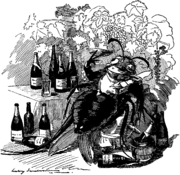
Leo Laliman
Encyclopedia

Wine
Wine is an alcoholic beverage, made of fermented fruit juice, usually from grapes. The natural chemical balance of grapes lets them ferment without the addition of sugars, acids, enzymes, or other nutrients. Grape wine is produced by fermenting crushed grapes using various types of yeast. Yeast...
grower and viticulturist from Bordeaux
Bordeaux
Bordeaux is a port city on the Garonne River in the Gironde department in southwestern France.The Bordeaux-Arcachon-Libourne metropolitan area, has a population of 1,010,000 and constitutes the sixth-largest urban area in France. It is the capital of the Aquitaine region, as well as the prefecture...
, France
France
The French Republic , The French Republic , The French Republic , (commonly known as France , is a unitary semi-presidential republic in Western Europe with several overseas territories and islands located on other continents and in the Indian, Pacific, and Atlantic oceans. Metropolitan France...
. He, along with fellow winegrower Gaston Bazille, is largely accredited for the discovery that when European vines are grafted
Grafting
Grafting is a horticultural technique whereby tissues from one plant are inserted into those of another so that the two sets of vascular tissues may join together. This vascular joining is called inosculation...
with suitable American
Americas
The Americas, or America , are lands in the Western hemisphere, also known as the New World. In English, the plural form the Americas is often used to refer to the landmasses of North America and South America with their associated islands and regions, while the singular form America is primarily...
rootstock, they become resistant to grape phylloxera. This discovery was very relevant at the time, when France was suffering from a severe wine blight induced by the same phylloxera
Phylloxera
Grape phylloxera ; originally described in France as Phylloxera vastatrix; equated to the previously described Daktulosphaira vitifoliae, Phylloxera vitifoliae; commonly just called phylloxera is a pest of commercial grapevines worldwide, originally native to eastern North America...
.
While Laliman was praised for his discovery, he was also a controversial figure at the time; for undocumented reasons, he was also branded by many as the introducer of the phylloxera, and, by extension, the crippling blight that came with it.
Background
The blight, termed the Great French Wine BlightGreat French Wine Blight
The Great French Wine Blight was a severe blight of the mid-19th century that destroyed many of the vineyards in France and laid to waste the wine industry...
, was a severe blight of the mid-19th century that resulted in the destruction of over 4 million vineyards and 40% of all the grape vines in France, and that subsequently laid waste to the wine industry there.
This blight was brought on by a species of aphid that originated in North America
North America
North America is a continent wholly within the Northern Hemisphere and almost wholly within the Western Hemisphere. It is also considered a northern subcontinent of the Americas...
and was carried across the Atlantic Ocean sometime in the late 1850s/early 1860s. However, how the phyolloxera had survived the journey remained a point of much debate; Europeans had experimented with American vines for centuries without any pestilential problems. Eventually, it was decided that, following the invention of steamboats, the grape phylloxera were able to survive the shortened journey.

Charles Valentine Riley
Charles Valentine Riley was a British-born American entomologist and artist.-Early Life:The son of a Church of England minister, Charles Valentine Riley was born on 19 September, 1843 in London’s Chelsea district. When he was around eleven his parents, the Rev. Charles and Mary Riley, chose to...
confirmed Planchon's theory. However, this discovery caused controversy; some met it with optimism, saying that now that the cause had been found, it would just be a matter of elimination. Others disagreed completely with the theory, saying that the grape phylloxera were merely a symptom, an effect, of the blight, rather than the source.
Solution
Shortly after Riley confirmed the theory proposed by Planchon, Laliman and Bazille, up until then two unknown winegrowers, proposed that the European vines, of the vinifera variety, may form a resistance to the destructive phylloxera if they were grafted with the American vine variety, which had formed a natural resistance.The idea was tested, and proved successful. Following this, France became divided again. Some, referred to as the "chemists", persisted with the use of pesticide
Pesticide
Pesticides are substances or mixture of substances intended for preventing, destroying, repelling or mitigating any pest.A pesticide may be a chemical unicycle, biological agent , antimicrobial, disinfectant or device used against any pest...
s and chemicals, while others, known as "Americanists", tried Laliman and Bazille's method.
Reward
The French government had, in desperation, offered a reward of over 320,000 FrancFranc
The franc is the name of several currency units, most notably the Swiss franc, still a major world currency today due to the prominence of Swiss financial institutions and the former currency of France, the French franc until the Euro was adopted in 1999...
s to anyone who could find a cure for the blight. Laliman, who was accredited over Bazille for the grafting solution, attempted to claim the prize money. However, the French government refused to award Laliman the money, claiming he had simply prevented the phylloxera's occurrence, rather than found a cure for it. However, it is speculated that there may have been other reasons that the French government refused to give Laliman the prize money; the idea of grafting rootstock for agricultural advantage was not a completely novel concept, and he was also mistrusted among a large portion of the population.

